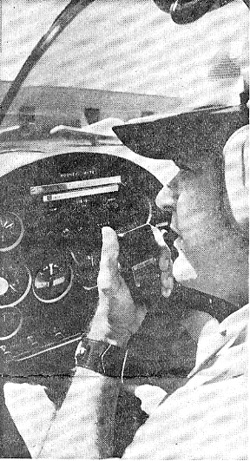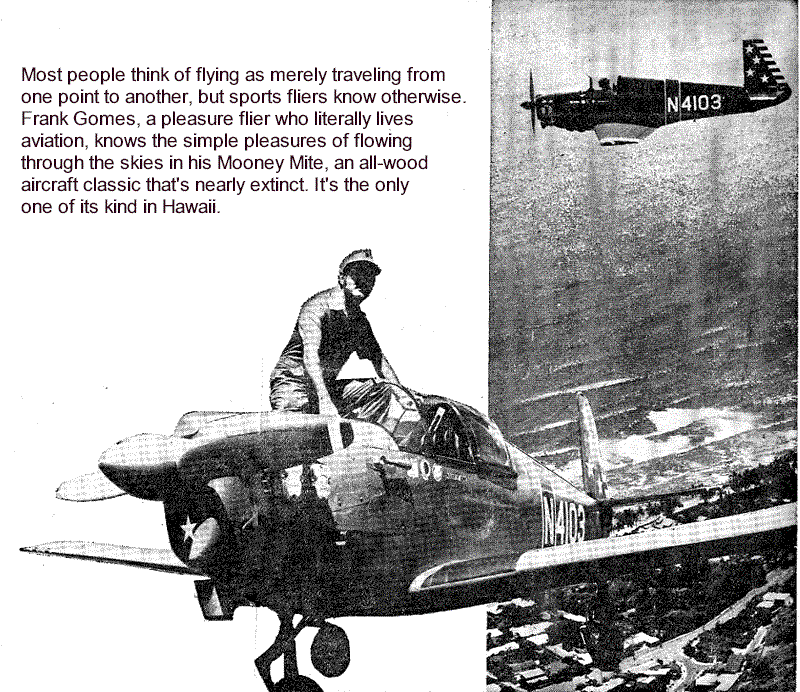
Airborne in a Rare Bird
by Jocelyn Fujii
This item is reproduced from an article aboout Frank Gomes and N4103 by Jocelyn Fujii, writer for the Honolulu Star-Bulletin. It was originally published on Tuesday, February 20, 1973. It came to us from Dick Rank, N125C who acquired it from the files of Fred Schmidt.

Photos by Warren Roll.
"You don't really get into it," Frank Gomes explained as he breathlessly wriggled into the pilot's seat. "You put it on like a suit of clothes. Ten more pounds and I'll never make it."
Ten more pounds and the plane, an all-wood, 65-horse-power gem called the Mooney Mite, wouldn't make it off the ground. Gomes wouldn't fit in it, either. If, on the other hand, the pilot succeeds in losing 10 pounds, he could equip the plane with a generator.
WEIGHT MATTERS IN the Mooney Mite more than in other single-engine planes. Made of aircraft-grade plywood, the light, easily buffeted one-seater can carry a maximum weight of 850 pounds with passenger and fuel. That is a little more than half the poundage of most small aircraft.
But the Mooney Mite is a special plane. It is a rare and beautiful aircraft classic, a species discontinued in 1955 and now almost extinct. It is the only one of its kind in the Islands and one of 200 still flying American skies.
They may well be the most conspicuous machines airborne. The flame-red body of Gomes' plane is starred and striped with blue and white. The pilot himself wears a matching flame-red jumpsuit, blue and white shoes and a watch with a blue airplane on its face.
But Gomes is more than a pilot to his little Mooney Mite. He speaks of it glowingly and affectionately, in the manner of a first-time father.
"It's really an oversized model airplane, but it has a personality. It was made on May 29, 1953," he said. "I received a letter about two weeks ago from the original owner who bought it 20 years ago. He's coming to Hawaii, and he went through a lot of trouble to find where it was so he can see it again."
 |
| Frank Gomes at the controls of his Mooney Mite |
ACCORDING TO GOMES, the plane was made by the Mooney Aircraft Corp. and the engine by Lycoming. Both are still in business today, he said, but Lycoming makes 100-horsepower engines and up, and Mooney puts out four-place, all-metal airplanes.
"When this came out," he said, "they thought there was no market for a single-place airplane. I think they're wrong."
Gomes, a project manager in the Dillingham Land Corp. and a retired Civil Air Patrol officer, wanted to own a Mite since he first read about the plane. After much looking, he found this one in 1966 on a deserted grass strip outside of Sacramento. He bought it then for a pittance—$1,700.
"It was so sad and neglected," he recalled.
He flew it to San Francisco, and shipped it from there to Honolulu. By the time it got here it had a bad case of dry rot, an affliction Gomes spent "oodles of money" to cure.
He said he sold the plane the following year, with the intention of buying it back. He did, but not until last July. By that time the Mite had been owned by two other people. The last owner installed 'a new engine, but the original sits in a heap in Gomes's 11th floor apartment.
There has been extensive renovation done on the plane's exterior as well. There are, as Gomes put it, "a million coats of wax" on it," and new upholstery, and it is all flame-proofed for safer flying.
"I've put in 100 hours since I bought it back in July," Gomes said. "It costs me $1 an hour to operate, eighty-seven cents a day' for hangar and the balance for fuel and oil. I can fly almost forever on a tank of gas. I can go to Maui and back for $2 at 110 miles per hour. The tank carries II gallons of fuel, and I can go 450 miles on II gallons of fuel. I used to rent planes that cost $20 an hour, and when I got out I didn't own them. Twenty dollars? I can fly for two months on that!"
Gomes' has flown to Maui and Hawaii, but because of winds and distance has avoided Kauai.
THE PLANE'S SIZE AND weight make precautions necessary, and Gomes is anything but reckless. He said he avoids flying in winds 20 knots and up because of the danger. "Flying's something you do for pleasure, and there's no pleasure in going out like that."
Because the airplane is coated with flame retardant and kept clean, he said, the possibility of its igniting from a loose spark is very remote. In a frightening juxtaposition that the pilot coolly accepts, the gas tank is situated directly behind the pilot's seat.
"I can land within 200 feet, on a road, on a pineapple field. The plane has such a glide ratio that if the engine cuts I can glide easily. It can stall at 43 miles per hour. But on a hot day, I can't get it to land. The heat thermals (from the ground or runway) keep the plane lifted away, so I have to literally fly the plane to the ground."
Part of Gomes' ease in handling his aviation anomaly comes from the fact that he has been flying since he was 16, when he polished planes at the airport in exchange for free lessons. He taught aerospace science at Maryknoll High School for awhile and was wing commander of .the Civil Air Patrol.
When he left CAP, his flying went from vocation to pastime, and today Gomes is among the scores of obsessed hobbyists who spend every available minute in the air.
HE BELONGS TO THE Mooney Mite Aircraft Association, a club of owners like himself who correspond and exchange information on spare parts and replacements. He also belongs to the International Acrobatic Club, the General Aviation Council of Hawaii, and the Experimental Aircraft Association, which in conjunction with the Mooney Mite club sponsors a yearly fly-in for members.
Gomes, of course, journeys yearly to Wisconsin for the fly-in, in which there are "literally thousands of home-built planes all over the field—wood, fiberglass, metal, in as good, if not better shape than those from the factory. A side benefit is meeting the other owners and seeing what they have done with their own rare birds.
IN HAWAII, SPORTS PILOTS like Gomes face what he sees as a critical problem—a shortage of runway and hangar space.
"Sports pilots like me are taxpayers," Gomes lamented, "but there's no airfield for us." They have to compete with military and commercial planes.
"The State has spent thousands of dollars to improve the yacht harbor, yet there's very little done for general aviation. All the improvements you hear about are for commercial fliers."
According to Gomes, Island sports pilots are hoping that some of the land at Dillingham and Bellows fields that the federal government is returning to the State will be turned over to general aviation.
"Right now there are about 20 home-made airplanes being built in Hawaii," he said, "in yards, people's garages, basements. What's going to happen when they're finished, where can they put them? Right now people have to wait seven and eight years for a hangar space. The only reason I have one is because my plane is small. It even gets morbid. When a small plane goes down, you hear about guys calling the FAA (Federal Aviation Administration) to ask where the guy was on the waiting list. When you wait seven or eight years, you get hungry."
Gomes said that most people think of flying as "getting from point A to point B," with little understanding of it as pure pleasure.
"In my job I work with people and their problems, and there are a lot of problems," he said. "All week I get this. So on Saturdays and Sundays, it's just us. No problems, no screaming, just me and her. It's the closest you can get to being a bird, and it's my way of getting away from it all."
2005-11-15